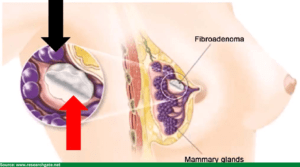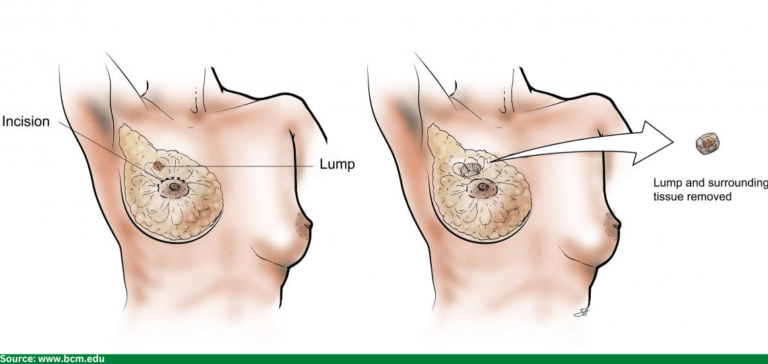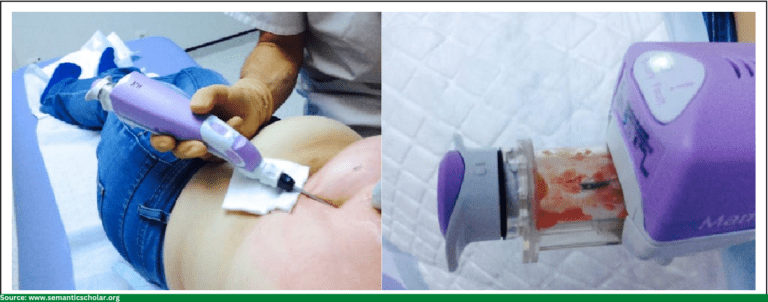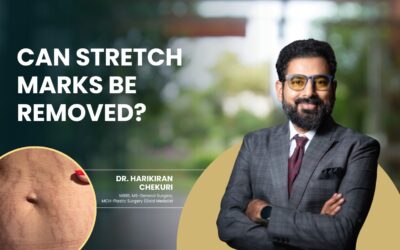Fibroadenoma Surgery In Hyderabad
A fibroadenoma is a benign (non-cancerous) breast tumor that typically occurs in women between the ages of 15 and 35, but it may develop in anyone in their reproductive life. It comprises glandular and fibrous tissue and feels firm and rubbery.
Fibroadenomas are usually small, ranging in size from a pea to a golf ball, and can occur singly or in groups. They are typically painless and do not cause any symptoms, although some women may notice a change in the shape or feel of their breasts.
“It is important to note that not all breast lumps are fibroadenomas, and it is crucial to have any breast abnormalities evaluated by a healthcare provider,” says Dr. Harikiran Chekuri. “Early diagnosis and treatment can help ensure the best possible outcome.”
Dr. Harikiran Chekuri is the founder of the world-class ReDefine Plastic Surgery & Hair Transplant Center. He is among the preferred surgeons for people seeking Fibroadenoma surgery in Hyderabad.

Diagnosing fibroadenomas
Diagnosing fibroadenomas typically involves a combination of physical examination, imaging tests, and biopsy.
Physical examination: The first step in diagnosis is usually a clinical breast exam, in which a healthcare provider palpates the breast to feel for abnormalities.
Imaging tests: If a lump or other abnormality is detected, the provider may order imaging tests such as mammography, ultrasound, or magnetic resonance imaging (MRI) to get a clearer picture of the breast tissue.
Biopsy: If the imaging tests suggest the presence of a fibroadenoma, the next step is usually a biopsy to confirm the diagnosis. A biopsy involves removing a small tissue sample from the breast for laboratory analysis. The tissue sample can be collected using a needle or during a surgical procedure.
Dr. Harikiran Chekuri, a well-known plastic surgeon in Hyderabad, says, “Fibroadenomas are generally not considered harmful, but they may be removed for cosmetic reasons or to rule out the possibility of cancer.”

Fibroadenoma breast surgery and what to expect
There are 3 types of fibroadenoma breast surgery: Lumpectomy, Vacuum-assisted excision biopsy (VAB), and Cryoablation. The choice of procedure will depend on the size and location of the tumor, as well as the preferences and needs of the patient.



Cost of fibroadenoma surgery
The fibroadenoma surgery cost depends on several factors, including the type of surgery being performed, the location of the fibroadenoma, the surgeon’s experience, and the surgery’s location.
The cost of fibroadenoma surgery can range from ₹60,000 to ₹80,000, depending on the above-mentioned factors.
Skin and hair specialist Dr. Harikiran Chekuri advises, “It is always important to discuss the cost of any procedure with your healthcare provider and insurance company to understand what will be covered and what out-of-pocket costs you may be responsible for.”
When is fibroadenoma surgery required?
Most fibroadenomas do not cause any symptoms and do not require treatment. However, in some cases, fibroadenomas may need to be removed if they cause discomfort or are causing concern due to their size or appearance.
Some common reasons for considering fibroadenoma surgery include:
- The fibroadenoma is large and causes discomfort or pain
- The fibroadenoma is causing cosmetic concerns
- Fibroadenoma is growing rapidly
- The fibroadenoma is causing problems with breastfeeding
- The fibroadenoma is raising concerns about cancer (although fibroadenomas are benign, they can sometimes resemble cancerous tumors and may need to be removed to rule out cancer)
- You have a family history of breast cancer
If you have a fibroadenoma and are considering surgery, please consult a highly-experienced cosmetic surgeon like Dr. Harikiran Chekuri to discuss your options.
Fibroadenoma removal surgery recovery time
Recovery time after fibroadenoma surgery will depend on the type of surgery performed and the individual’s overall health. Here is a general overview of the recovery time for some common types of fibroadenoma surgery:
Lumpectomy: Most people can return to normal activities within a week after a lumpectomy.
Vacuum-assisted excision biopsy (VAB): Most people can return to their daily routine within a day or 2 after a VAB.
Cryoablation: Typically, people can resume everyday activities in a few days. You may be asked to wear a bra throughout the day and apply waterproof plaster for about 72 hours.
All these surgeries are usually outpatient procedures and do not require a hospital stay.
“However,” cautions aesthetic surgeon Dr. Harikiran Chekuri, “it is important to follow your healthcare provider’s instructions for caring for the incision site and avoid strenuous activities for at least 2 weeks after the procedure”.
Can fibroadenomas grow back after removal?
If a fibroadenoma is removed, it is generally considered to be cured. However, a new fibroadenoma can develop in the breast tissue after surgery. This is more likely to occur in women who have had multiple fibroadenomas in the past or who have a family history of fibroadenomas.
It is essential to follow up with your healthcare provider after fibroadenoma surgery to ensure that the tumor has been completely removed and to monitor for any new growth. Your provider can recommend the appropriate follow-up care based on your specific situation.
Post-surgery care
Here are some general guidelines for aftercare following fibroadenoma surgery:
Take care of the incision site: You may have a bandage or dressing over the incision site. Keep the area clean and dry, and avoid getting the incision site wet or soaking it in water. Follow your healthcare provider’s instructions for caring for the incision and changing the bandage.
Take pain medication as prescribed: It is essential to take the medication prescribed by your healthcare provider to help manage any discomfort after surgery.
Avoid strenuous activities: Strictly avoid strenuous activities, such as heavy lifting or exercise, for a period after surgery to allow the incision site to heal properly. Check with your healthcare provider when it is safe to return to normal activities.
Follow-up with your healthcare provider: Do miss follow-up sessions. These sessions are to ensure the fibroadenoma is destroyed and to check for signs of any new growth.
Fibroadenoma breast surgery – success rate
Surgery is often used to remove fibroadenomas, and the success rate of this procedure is generally very high. In most cases, the fibroadenoma is completely removed and does not recur.
Why choose us?
Top-notch aesthetic surgeon Dr. Harikiran Chekuri and his team of skilled and experienced surgeons are dedicated to delivering excellent results.
We are committed to providing the highest quality care to our patients at Redefine Hair Transplant & Plastic Surgery Center. We have a modern operating room equipped with the latest technology, which helps to ensure a safe and efficient procedure.
We understand that surgery can be a stressful and anxious experience, and we do everything we can to make it as comfortable and smooth as possible.
Our team of experienced surgeons, state-of-the-art facilities, and commitment to patient care make us a top choice for people seeking treatment for fibroadenoma. If you are considering surgery for fibroadenoma, please consult our specialist to learn more about our facility and services.
Frequently Asked Questions
Is fibroadenoma a major surgery?
In most cases, fibroadenoma surgery is a relatively minor procedure. The surgeon will make a small incision in the breast and remove the fibroadenoma using special instruments. The incision will then be closed with stitches or staples. The surgery usually takes only a few hours to complete.
Dr. Harikiran Chekuri adds, “The extent of the surgery depends on the size of the fibroadenoma.”
Is fibroadenoma surgery painful?
Fibroadenoma surgery is generally not considered to be a painful procedure. The surgery is typically performed under local anesthesia, which numbs the area being treated, or under general anesthesia, which puts the patient to sleep. This means that the patient should not feel any pain during the surgery.
After the surgery, the patient may experience some discomfort and swelling in the breast. This is normal and can usually be managed with over-the-counter pain medications, such as acetaminophen or ibuprofen. The swelling and discomfort should subside within a few days to a week.
How long does it take to recover from fibroadenoma surgery?
The length of the recovery period is determined by the type and degree of the surgery. It differs from person to person and takes the removal techniques into account. In most cases, the recovery period in these situations is 1 – 2 weeks, and complete healing may take up to 1 month.
Is it better to remove fibroadenoma?
In most cases, fibroadenomas do not cause any symptoms and do not require treatment. However, some people choose to have them removed for cosmetic reasons or because they are concerned about the potential for the fibroadenoma to grow or change over time.
RECENT ARTICLE
Every Single Update And Recent Story
From Our Blog
Does Dandruff Cause Hair Loss?
Dandruff is not a direct cause of hair loss but it does lead to hair fall if the dandruff is not treated. Dandruff is a common condition of the scalp that results in flaky skin, itchy skin, and irritated skin. The causes of dandruff range from excess oil production on...
Can Stretch Marks Be Removed?
Although it is rare for them to be completely removed, there are ways in which the appearance of stretch marks can be greatly improved with medical treatments. Stretch marks (known as striae) develop when skin stretches quickly and eventually forms small tears in the...
Can Shampoo Cause Hair Thinning?
Using the incorrect type of shampoo or using shampoo improperly may not cause permanent hair loss but could be contributing factors to increased hair loss from the scalp and/or scalp-related issues. Genetic makeup, hormonal fluctuations, nutritional levels, levels of...



